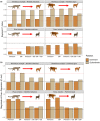Inferring predator-prey interactions from camera traps: A Bayesian co-abundance modeling approach
- PMID: 36523521
- PMCID: PMC9745391
- DOI: 10.1002/ece3.9627
Inferring predator-prey interactions from camera traps: A Bayesian co-abundance modeling approach
Abstract
Predator-prey dynamics are a fundamental part of ecology, but directly studying interactions has proven difficult. The proliferation of camera trapping has enabled the collection of large datasets on wildlife, but researchers face hurdles inferring interactions from observational data. Recent advances in hierarchical co-abundance models infer species interactions while accounting for two species' detection probabilities, shared responses to environmental covariates, and propagate uncertainty throughout the entire modeling process. However, current approaches remain unsuitable for interacting species whose natural densities differ by an order of magnitude and have contrasting detection probabilities, such as predator-prey interactions, which introduce zero inflation and overdispersion in count histories. Here, we developed a Bayesian hierarchical N-mixture co-abundance model that is suitable for inferring predator-prey interactions. We accounted for excessive zeros in count histories using an informed zero-inflated Poisson distribution in the abundance formula and accounted for overdispersion in count histories by including a random effect per sampling unit and sampling occasion in the detection probability formula. We demonstrate that models with these modifications outperform alternative approaches, improve model goodness-of-fit, and overcome parameter convergence failures. We highlight its utility using 20 camera trapping datasets from 10 tropical forest landscapes in Southeast Asia and estimate four predator-prey relationships between tigers, clouded leopards, and muntjac and sambar deer. Tigers had a negative effect on muntjac abundance, providing support for top-down regulation, while clouded leopards had a positive effect on muntjac and sambar deer, likely driven by shared responses to unmodelled covariates like hunting. This Bayesian co-abundance modeling approach to quantify predator-prey relationships is widely applicable across species, ecosystems, and sampling approaches and may be useful in forecasting cascading impacts following widespread predator declines. Taken together, this approach facilitates a nuanced and mechanistic understanding of food-web ecology.
Keywords: N‐mixture models; detection probability; hierarchical modeling; overdispersion; species interactions; zero inflation.
© 2022 The Authors. Ecology and Evolution published by John Wiley & Sons Ltd.
Conflict of interest statement
The authors declare no conflict of interest pertaining to the research conducted here.
Figures





References
-
- Blasco‐Moreno, A. , Pérez‐Casany, M. , Puig, P. , Morante, M. , & Castells, E. (2019). What does a zero mean? Understanding false, random and structural zeros in ecology. Methods in Ecology and Evolution, 10, 949–959. 10.1111/2041-210x.13185 - DOI
Associated data
LinkOut - more resources
Full Text Sources
Other Literature Sources

